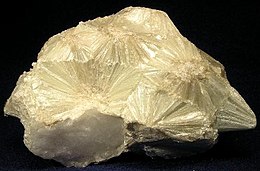| Pyrophyllite | |
|---|---|
 Pearly radial cluster of pyrophyllite from Hillsborough District, Orange County, North Carolina (Size: 11 × 7.3 × 6.6 cm) | |
| General | |
| Category | Silicate minerals |
| Formula (repeating unit) | Al2Si4O10(OH)2 |
| IMA symbol | Prl[1] |
| Crystal system | Monoclinic[2] or triclinic[3] |
| Crystal class | Prismatic (2/m) or pinacoidal (1) |
| Space group | C2/c or C1 |
| Unit cell | a = 5.16 Å, b = 8.966(3) Å, c = 9.347(6) Å; α = 91.18°, β = 100.46°, γ = 89.64°; Z = 2 |
| Identification | |
| Formula mass | 360.31 g/mol |
| Color | Brown green, brownish yellow, greenish, gray green, gray white |
| Crystal habit | Compact spherulitic aggregates of needlelike radiating crystals; as fine grained foliated laminae, granular, massive |
| Cleavage | [001] Perfect |
| Tenacity | Flexible inelastic |
| Mohs scale hardness | 1.5–2 |
| Luster | Pearly to dull |
| Streak | white |
| Diaphaneity | Translucent to opaque |
| Specific gravity | 2.65 – 2.9 |
| Optical properties | Biaxial (−) |
| Refractive index | nα=1.534–1.556, nβ=1.586–1.589, nγ=1.596–1.601 |
| Birefringence | δ =0.0450–0.0620 |
| 2V angle | 53–62 |
| Fusibility | Infusible, exfoliates |
| References | [2][3][4][5][6][7] |
Pyrophyllite is a phyllosilicate mineral composed of aluminium silicate hydroxide: Al2Si4O10(OH)2. It occurs in two forms (habits): crystalline folia and compact masses; distinct crystals are not known.
The folia have a pronounced pearly luster, owing to the presence of a perfect cleavage parallel to their surfaces: they are flexible but not elastic, and are usually arranged radially in fan-like or spherical groups. This variety, when heated, exfoliates and swells up to many times its original volume. The color of both varieties is white, pale green, greyish or yellowish; they are very soft (hardness of 1.0 to 1.5) and are greasy to the touch. The specific gravity is 2.65–2.85. The two varieties are thus very similar to talc.
- ^ Warr, L.N. (2021). "IMA–CNMNC approved mineral symbols". Mineralogical Magazine. 85 (3): 291–320. Bibcode:2021MinM...85..291W. doi:10.1180/mgm.2021.43. S2CID 235729616.
- ^ a b Mindat
- ^ a b http://webmineral.com/data/Pyrophyllite.shtml Webmineral
- ^ Handbook of Mineralogy
- ^ Hurlbut, Cornelius S.; Klein, Cornelis, 1985, Manual of Mineralogy, 20th ed., p. 430 ISBN 0-471-80580-7
- ^ Lee, J.H.; Guggenheim, S. (1981). "Single crystal X-ray refinement of pyrophyllite-1Tc". American Mineralogist. 66: 350–357. Retrieved 30 December 2020.
- ^ Gruner, J.W. (1934). "The crystal structures of talc and pyrophyllite". Zeitschrift für Kristallographie. 88 (1–6): 412–419. doi:10.1524/zkri.1934.88.1.412. S2CID 101680970.